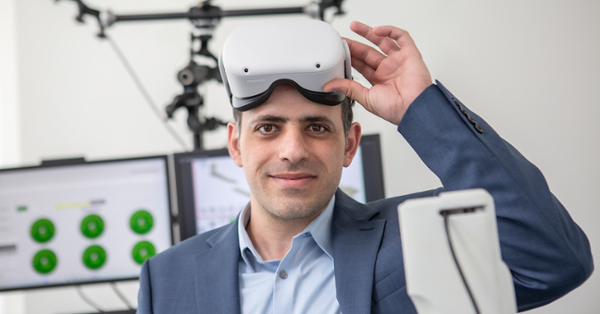Rowan researcher awarded $1.8 million NIH grant for pioneering robotic-surgery system
Rowan researcher awarded $1.8 million NIH grant for pioneering robotic-surgery system

A Rowan University researcher is developing the first robotic-surgery system designed to align fractured long bones, such as the thigh bone (femur). These bones often don’t heal properly due to misalignment—causing pain, difficulty walking, and other long-term problems.
Mohammad Abedin-Nasab, Ph.D., and his research team have won a $1.8 million grant from the National Institutes of Health (NIH) to further develop the system—named Robossis—and bring it to market.
The research “could have a huge impact in reducing malalignment, reoperation and even mortality for patients with femur fractures, a large and growing population,” according to the NIH reviewers. More than 430,000 femur fractures occur annually nationwide, and that figure is expected to rise due to an aging population, Abedin-Nasab said.
“Up to 28% of all long-bone fractures don’t heal correctly, as it’s difficult for surgeons to align the separated segments of these bones,” explained Abedin-Nasab, who has been working on Robossis for ten years.
“Our goal is to help address the challenges of treating these fractures and improve outcomes for patients,” noted the associate professor of biomedical engineering in the Henry M. Rowan College of Engineering and the Rowan-Virtua School of Translational Biomedical Engineering & Sciences.
Research team member Christopher Haydel, MD, an orthopedic trauma surgeon at Virtua Reconstructive Orthopedics, described a key challenge that Robossis could address.
“Fractures of the thigh bone are common, and the surgery is physically difficult to conduct. An assistant has to hold the leg in place, pushing against large muscle groups for an extended period. Robossis could make holding that alignment far easier and with greater consistency and accuracy,” Haydel explained.
Additionally, Robossis could make femur realignment surgery less invasive. The robot makes only small incisions, which can limit blood loss, post-surgical pain and scarring. Robossis also requires fewer X-rays than traditional surgery, reducing radiation exposure for patients and health care providers.
Next steps
The R01 grant, the NIH’s original and most prestigious funding program, will be used to create and test a clinical-grade version of Robossis, based on the current prototype. The patented robotic system will initially focus on repairing femur fractures. It could later be used on other long bones in the legs and arms.
The new system will include enhancements to meet the Food and Drug Administration’s stringent safety and efficacy requirements. The research team will then conduct five new studies, evaluating the system’s performance on cadavers before presenting results to the FDA.
How the robot works
Robossis consists of three components: the robot, the haptic controller (a controller that provides physical feedback), and a navigation system that automatically aligns the bone.
Using X-ray images from two angles and cameras to track the fractured pieces, Robossis creates a 3D computer model of the surgical site and recommends a path to precisely realign the broken bone. The surgeon can then manipulate both the robot and the patient’s leg using the haptic controller, while viewing the animated model through a virtual reality headset.
A surgical assistant would no longer need to stabilize and align the leg manually.
Robossis is among Rowan’s first NIH-backed, translational research projects with a combined investigator team that includes Virtua Health—a result of Rowan’s academic health partnership with southern New Jersey’s largest health system. Translational research turns scientific discoveries into medical advances that directly benefit patients.
Abedin-Nasab’s team includes orthopedic surgeons from Virtua Health and researchers at Johns Hopkins University. Also on the team are students from Rowan-Virtua School of Translational Biomedical Engineering & Sciences and the Rowan-Virtua School of Osteopathic Medicine—both part of Virtua Health College of Medicine & Life Sciences.
About Henry M. Rowan College of Engineering: A national leader in engineering education, Henry M. Rowan College of Engineering was established in 1995, following a transformative $100 million gift from Henry and Betty Rowan to the public institution that became Rowan University. The nationally recognized college provides a hands-on, minds-on educational experience, degree programs and research in the following engineering fields: biomedical, chemical, civil and environmental, construction management, electrical and computer, electrical engineering technology, engineering education, engineering entrepreneurship, engineering management, mechanical engineering and mechanical engineering technology.
About the Virtua Health College of Medicine & Life Sciences of Rowan University: Established in 2021, the Virtua Health College of Medicine & Life Sciences of Rowan University is an historic new academic health partnership between Rowan University, a top 100 public research institution, and Virtua Health, South Jersey’s largest health system. The college encompasses the state’s only osteopathic medical school; an expanded nursing and allied health professions school; a new school of translational biomedical engineering and sciences; multiple research institutes and centers; and aligned clinical practices to improve patient care and train the health care workforce, so they can be the leading caregivers of tomorrow. Dedicated to improving health for all, the college will transform the practice of medicine using an approach that treats the whole person, not a disease. Driven by world-class physicians and researchers on the leading edge of science, the college aspires to become a national leader in health care education, discovery, and innovation.